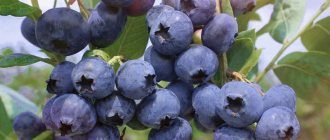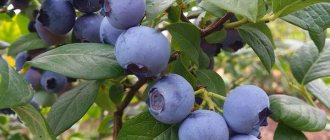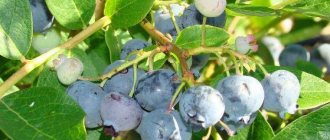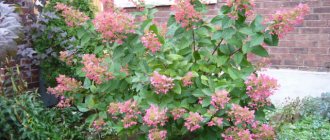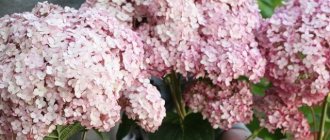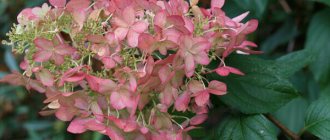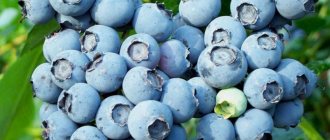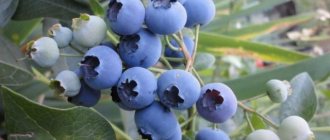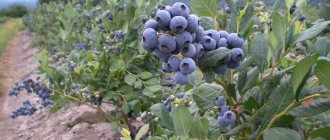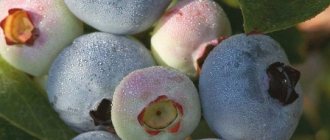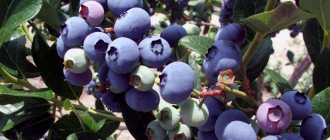Loading…
Loading…
The mountain slopes of North America are covered with hundreds of bushes of this plant. An inhabitant of highlands and swamps, blueberries are known for their exquisite taste, as well as their luxurious appearance. The miniature tree grows a huge variety of small (up to 1 cm) dark blue berries with a bluish tint. The sickly sweet aftertaste of this delicacy remains in the memory for a long time, which encourages many tourists to return here again and again.
This berry is known under such pseudonyms as gonobol, fool's sake and water drinker. Blueberries received such fancy nicknames due to the places where they grow and the plants that live in their neighborhood.
Habitat
You can find a branched shrub reaching 1-3 m in height most often in cool and humid climates. A rainy summer is the key to a rich harvest for him. The temperate latitudes of Russia, Western Europe, the Caucasus, Siberia, the Urals and the Far East are the homeland of the shoot. However, her native places are Canada and the USA. Scientists in Germany and Poland have learned to cultivate and breed blueberry hybrids; photos of some of them are given below.
Waterdrinker belongs to the unpretentious plants of the Heather family, so it thrives in acidic and depleted soils. Its main habitat is:
- peat bogs;
- mixed forests (conifer needles, pine and larch);
- moss-covered slopes;
- rocks;
- thickets of dwarf pine;
- tundra.
Wild rosemary most often grows next to blueberries. Because of the specific and intoxicating aroma that envelops the bush, it received such unusual folk names.
You can also grow this wild berry in your country house. However, first you should choose the appropriate and best blueberry varieties for the Moscow region in order to get excellent results. Here are some of them:
- Bluecrop and Blugold. An excellent choice for this climate because the berries have a firm, dense texture.
- Patriot. Bred specifically for these places.
- Duke. Came from North America, where climatic conditions are similar.
Gardeners recommend not stopping at one species, but planting several at once. If one disappears due to weather, the others will remain. These varieties successfully withstand sharp drops in temperature. Even the color of the plant can withstand such anomalies (-7°C). In this region, harvesting can begin as early as the last days of August.
Berries should be picked carefully so as not to pick off the poisonous leaves of wild rosemary. If this happens, you need to remove the fruits that come into contact with it from the basket, and then disinfect your hands.
Description and benefits
A common mistake made by many is to confuse blueberries with blueberries, so it is important to know all the signs of its description. Outwardly, these close “relatives” are similar. However, the inside is completely different. Blueberries have burgundy-colored flesh, while fool's sake has light green flesh. At the same time, the fruits of the water drinker are larger. It also does not leave stains on clothes. Externally, blueberries are distinguished by the following characteristics:
- Bush. Young stems are greenish in color, but over time they become brown. They grow straight and very densely.
- Leaves. Hard with brightly highlighted veins on a light green background. The edges are slightly curved, and the length of each of them is about 3 cm. The inner side of the elliptical leaf has a bluish waxy coating. When cold weather sets in, they turn bright red and then fall off.
- Flowers. White slightly pale pink elongated bells with a jagged edge. They grow in inflorescences of 2-3 flowers from one petiole. The short peduncle bends under the weight of the jug. The first shoots appear in May and adorn the majestic mountain slopes throughout June.
- Fruit. They ripen by July, and can be collected until the end of September. The weight of 1 fruit is about 3 g, and the diameter is up to 1-2 cm. It is often shaped like a ball. Although there are varieties of blueberries with pear-shaped, elliptical and cylindrical berries. A luxurious dark blue velvet color with a bluish tint makes it a precious pearl of the marshes. The watery greenish pulp leaves behind a sweet, even cloying, sour taste.
Collecting water booze is an art. The dense branches of the bush hold the tiny berries captive. Therefore, you need to work hard to get yours. As a result, you can make compote, preserves, wine, juice, jam, puree and kvass from the fruits. It is very useful to eat fresh berries. They are rich in vitamins, minerals and antioxidants, which:
- improve vision;
- increase hemoglobin;
- lower blood glucose levels (diabetes);
- prevent the formation of cancer cells;
- promote the production of bile;
- increase immunity;
- relax the intestines;
- develop appetite;
- remove toxins from the body.
Such an impressive resume of this representative of the Vaccinium genus encourages many gardeners to grow berries in their garden plots. For the first 3 years, the luxurious greenery of the bush only decorates the garden and only in the 4th year it produces a harvest, and will bear fruit for more than 90 years. Which blueberry variety should you choose for your residence?
Pink blueberry variety Pink Lemondate - sweet and tasty but heat-loving variety
The unusual color of the Pink Lemonade blueberry variety appears at first glance to be an unripe yellow-green, but over time it becomes more variegated, a light fuchsia pink when fully ripe. Pink Lemonade blueberries (Vaccinium Pink Lemonade), like their blue relatives, have a dense texture and are very juicy. At the same time, blueberries of this variety have a much higher sugar content with a noticeable lemon aroma, which fully justifies the name of the variety, which can be translated as “Pink Lemonade.” The blueberry aroma of this variety can be described as “sweet and floral.”
The Pink Lemonade blueberry variety is a mid-late variety developed in the USA. This variety is primarily used by hobbyists for the production of berries, and also as an ornamental shrub due to its white-pink flowers in spring and bright red leaves in autumn. The Pink Lemonade variety is self-pollinating.
Despite the fact that the berries of the variety seem unripe, they surprise with the level of sweetness and a very pleasant aroma. Pink Lemonade blueberries contain approximately the same amount of antioxidants and minerals as other blueberries. They are a good source of vitamins C and K, as well as dietary fiber.
The high sugar content of Pink Lemonade blueberries makes them ideal for consumption both fresh and for use in cooking, particularly baking. Pink Lemonade blueberry jam will have the familiar blueberry flavor but an unusual pink color. The big advantage of this variety is that the berries do not give baked goods a dark color, like their blue counterparts.
Like most varieties, Pink Lemonade blueberries prefer acidic soil. As a rule, pine needles are used as a natural mulch when growing blueberries of this and other varieties, because, when destroyed, they increase the acidity of the soil.
Pink Lemonade blueberries were developed by the USDA. Breeders worked on it for ten years. The variety was obtained by crossing one of the experimental blueberry varieties with the commercial Delite variety. The variety was first introduced in 2005 as "ARS 96-138". This variety received its official name in 2007. The Pink Lemonade variety is better suited for cultivation in warm regions where the temperature does not fall below 17 degrees Celsius.
EastFruit
Use of site materials is free provided there is a direct hyperlink to a specific publication open to search engines.
Main news and analytics of the fruit and vegetable market on Facebook and Telegram - Subscribe!
- 1
- 1
Share
Sadovaya
Garden blueberries originate from the northeastern territories of Canada and the United States. It is in this area that many swamps, coniferous and deciduous forests are concentrated, which are flooded with water most of the time. In such a humid climate, shrubs reach more than 2-3 meters in height. Therefore, they serve as a middle layer for a densely growing forest.
Unlike other representatives of the Ericaceae family, highbush blueberries are not poisonous (without harmful esters and resins), so they can be planted near the house or garden. In addition, decoctions, teas, and other medicinal drugs are prepared from the leaves and shoots. The peculiarity of this variety of drunken berry is:
- Erect stems of a brown hue, not creeping along the ground. The thickness of the branches is 1-4 cm.
- A fibrous root system that is held to the surface of the soil. There are no suction hairs on the roots.
- The branches do not bend to the ground and cannot take root in the ground.
- The fruits are larger and sweeter in taste.
- The yield from one bush (up to 8 years old) is more than 5 kg. The collection begins on the 15th of August.
The disadvantage of tall varieties is their instability to frost. But the Berkeley variety, on the contrary, can withstand sudden changes in temperature, but deteriorates during transportation and long-term storage.
Bushes of tall crops should be pruned frequently to increase the growth of young trees. This should be done in the first half of the 3rd year. You need to cut off weak, damaged and low-growing stems, leaving a maximum of 5 shoots.
Care after landing
When caring for a crop, the main thing is to adhere to the schedule for carrying out all the necessary manipulations.
Read all about caring for blueberries in the fall.
Watering and fertilizing schedule
Watering pink blueberries is done once or twice a week. After each irrigation procedure, it is necessary to loosen the soil to a depth of 8 cm. Fertilizers are applied twice per season: in the spring, before the sap begins to flow, and in June. Mineral fertilizers are used. It is imperative to weed the beds with bushes. The weed is destructive for young plants.
Video: care and planting of blueberries
You should also provide timely care, removing diseased, damaged, old branches. It is advisable to thin out small growths of bushes, leaving 5-6 strong shoots on them.
Important! In order for the plant to survive the winter better, its shoots need to be bent to the ground and sprinkled generously with snow.
Blueberries Pink Lemonade are quite an attractive crop for growing in your summer cottage. It can be used as a fruit and ornamental plant. She is not very picky when it comes to grooming.
Bluecrop
It can be grown for both personal use and commercial purposes. The variety was bred by American breeders. Of all the industrial land in Western Europe, over 60% is accounted for by Bluecrop blueberries. This choice is due to the following cultural characteristics:
- The fruits do not ripen at the same time. Collection begins at the end of July and throughout August.
- It tolerates frost (-30°C, and -7°C during flowering) and drought without problems. Withstands temperature fluctuations. Resistant to pests and diseases.
- The height of the bush is from 1.6 to 2 m.
- Large berries (2 cm in diameter) have an elastic, dense structure. A distinctive feature is the unusually light coating.
- They do not crack or spread during transportation. Excellent storage.
- Productivity is from 5 to 10 kg per bush.
- A lush crown of wide, large leaves will serve as a hedge for the garden. Relevant for early or late season.
The natural habitat of this hybrid is the climate of Russia, Belarus, and Ukraine. Mostly temperate latitudes, where mountains, swamps and forests are located.
This culture can be propagated by layering. A long branch should be buried in a specially prepared hole 3 m from the bush and tied to a bar.
Description of the variety
The plant reaches two meters in height.
Blueberry leaves of the Bluecrop variety are rich dark green in color and oblong in shape. The foliage gives the bushes a decorative appearance, especially in autumn.
The bush requires regular pruning, the absence of which leads to a decrease in yield.
The plant begins to bear fruit at 3–4 years. The berries are dark blue, slightly flattened, large, and have a pronounced light blue coating. Reach 1.7–2 cm in diameter. Weight - about 2 g.
Changes in the color, shape and diameter of berries and leaves indicate that the plant is unwell. Some changes are hallmarks of diseases.
The fruits hang on long clusters and ripen in August. These ripening dates are valid for the European part of Russia. In regions with different climates, the dates may shift.
Bushes strewn with berries are an undoubted advantage of Bluecrop blueberries
The advantages of the variety include:
- high yield (6–9 kg per bush);
- frost resistance (up to -34ºС);
- disease resistance.
- extreme overload of bushes with fruits;
- extended fruiting period, complicating the sale of berries in bulk.
Video: Bluecrop blueberries and blueberries
Patriot
Another variety that is frost-resistant and can easily withstand temperatures of -30°C. The shape of the Patriot blueberry fruit resembles an ellipse, flattened at the top and bottom. In comparison with their relatives, Patriot fruits are red in color when ripe, rather than light green. Ripe berries acquire a royal blue color with a bluish tinge. They are collected in rich clusters, so the primary harvest should not be harvested mechanically. The advantages of Patriot culture include:
- The root system is resistant to late blight and rotting.
- Capable of self-pollinating. If you plant the bushes closely, this leads to cross-pollination.
- The first fruits are large, but subsequent batches are slightly smaller.
- High yield. Up to 7 kg from an average plant. The shrub reaches 2 m in height.
This variety of gonobol grows in very unfavorable, almost depleted soils, because it is able to adapt to harsh conditions. Tolerates wet soils prone to flooding.
The bush thickens very quickly, throwing out new branches. In this regard, it should be intensively pruned. The shoots are in dire need of thinning.
Expert advice on choosing blueberry varieties
Highbush blueberries are one of the few berry crops that have received such widespread recognition in recent years. It must be said that this is an artificially created culture. Almost all modern varieties are hybrids obtained from crossing different North American species.
The introduction of useful plants, the creation of their collections and the identification of the most promising taxa for widespread cultivation is one of the main tasks of the Central Botanical Garden, in particular the industrial laboratory for the introduction and technology of non-traditional berry plants, headed by Nikolai Pavlovsky, Candidate of Biological Sciences. The laboratory was created 40 years ago on the basis of the experimental production plantation of large-fruited cranberries of the Gantsevichi forestry enterprise. Here, in Zhuravinka, in 1980, the first seedlings of the then unknown highbush blueberry arrived. These were varieties such as “Rancocas”, “Concord”, “Atlantic”, “Delight”, “Tifblue”, “Dixie”.
Today the collection already includes more than 60 varieties of this crop. And in order to get to know this berry better, the environmental public association “Green Initiatives of Polesie” organized a visiting seminar for berry farmers as part of a project to introduce a cluster system in Belarus. And I must say that there were a lot of questions. I want to focus exclusively on varieties. Many people are already growing highbush blueberries on their plots, while others are just thinking about it. Knowledge of varieties and their characteristics is a great help when starting a plantation.
— Nikolai
Boleslavovich, how many varieties have already been zoned?
Which ones are considered promising? — To date, 17 varieties of blueberries have been entered into the state register. The latter include Elliott and Spartan. Large-fruited varieties such as “Blugold” and “Sunrise” are also worthy of being zoned.
There are really many varieties in our collection. There are both old North American ones and new ones from other countries and continents. And everyone has their own strengths and weaknesses. The most universal variety for Belarus is “Bluecrop”: mid-season, not capricious and not demanding on the soil.
The “Toro” variety is very large-fruited; “Spartan” and “Blugold” are no less productive. “Spartan” also has large berries, but slightly soft. The early variety "Sunrise" also has large and very sweet berries.
"Berkeley" reproduces easily, is unpretentious, but does not tolerate sudden temperature fluctuations in winter. "Blugold" is valued for its medium ripening period, unpretentiousness, high yield and good taste. "Bluejay", "Spartan" and "Blueray" are resistant to moniliosis, branch dieback and berry mummification.
Darrow's fruits do not fall off or crack even in wet weather. Coville tends to thicken, making pruning difficult. But the ripe berries hold on very tightly and do not fall off for a long time. "Nelson" has irregular but high yields - up to 5 kg per plant. Moreover, ripe berries do not fall off for a long time.
The Polish variety “Boniface” also performed well. It blooms late, after the May spring frosts, which protects the flowers from damage.
Among the New Zealand varieties, Brigitte Blue is considered one of the most promising and highly productive. The berries ripen evenly and do not fall off for a long time. "Nui" also has large berries - up to 2.5 g in weight and up to 21 mm in diameter. They ripen in tight clusters resembling bunches of grapes. The pulp is very dense and “crispy”.
Even under extreme weather conditions (long rains, drought, significant temperature fluctuations), the berries of the Puru variety do not lose their quality. The fruits don’t fall for a long time at the “River” either. In addition, this variety is very frost-resistant and disease resistant.
"Aurora" is a late variety and is suitable for cultivation only in the Brest region.
"Huron" is one of the new American varieties. It blooms late, which reduces the risk of damage to flowers by late frosts.
“Duke” is early ripening, the berries are tasty and dense, transportable, but the variety itself is very capricious to the soil and very demanding on agricultural technology.
Mid-early ripening "Nortland" grows well and intensively. It has very tasty sweet fruits, and they can be harvested immediately after ripening, without waiting 5-7 days for sugar to accumulate. But the bush itself requires more careful pruning. And the fruits are more tender than those of Bluecrop - you can’t transport them over long distances.
"Bluetta" is the earliest variety, highly productive. But the part of the berry that is attached to the stalk very often remains reddish.
A very early ripening variety and "Weymouth". It is very highly productive and high-yielding. Soil and moisture tolerant - survives in almost any conditions. But the berries are medium in size and poorly transportable.
“Hardiblu” is undemanding to soil conditions, the fruits are medium in size and very sweet, but the waxy coating on them is barely noticeable.
"Elizabeth" ripens late. Sometimes there is a periodicity of fruiting. The berries are large (like buttons) and sweet. The downside is that it can only be grown in the southern and central parts of Belarus.
"Collins" is an early-mid-ripening and highly productive variety, but the fruits are not large and not long-lasting.
The late variety “Jersey” bears fruit regularly, even if it produces only 3–4 kg per bush. But the berry is very tasty. And the plant itself is not picky about soil conditions and can withstand drought.
"Patriot" is early, large-fruited and not very tall. The taste of the berries is slightly fresh and not pronounced.
"Elliott" is the latest ripening variety among the zoned ones. High-yielding, but since it ripens later, the berries are slightly sour - still there is not enough sun for the growing season. Northblue's fruits are also slightly sour.
“Liberty” is also a good variety, but you shouldn’t bet on it alone. The late variety “Rubel” has not yet been zoned. It was selected back in 1906 from a natural population by forester Rube Lee (after whom, in fact, it received its name). And this is not a hybrid, but a natural form of natural blueberry. At the same time, it is very productive and productive. The fruits are sweet, but small and do not fall off for a long time. It was involved in selection as a bearer of abundant fruiting.
More recently, “Cargo”, “Eureka” and the late-ripening variety “Cosmopolitan” appeared in our collection.
In Belarus, early-ripening varieties begin to ripen in the first half of July, mid-ripening varieties in the second, and late-ripening varieties in the first half of August.
If we draw a line in terms of ripening, then “Weymouth” and “Bluetta” yield the first crops, and “Elliott” and “Liberty” last.
— Which varieties are the largest-fruited and most productive?
— The largest berry is “Chandler” - up to 4 cm in diameter. But I want to say a few words in defense of small-fruited varieties: they are much healthier. And all because they have a large area of skin per volume of mass (there is such a term in gardening). And it contains most of the biologically active substances. Therefore, blueberries must be eaten with the skin on.
The most productive variety is “Weymouth”: it can produce a bucket of berries from a bush. True, next year the figures will be much lower. Therefore, it is necessary to regulate fruiting by cutting out shoots. Especially if the flowering is very lush. Sometimes, due to the abundance of flowers, few leaves are formed. And only thinning can save the situation.
Do not overload the plant with the harvest. This can lead to the fact that the fruits will be small, sour, and will also take longer and later to ripen. A plant burdened with a harvest will produce much fewer flower buds for the next season.
— The state register includes 2 varieties of semi-high blueberries - “Northcountry” and “Northblue”. What is special about this species?
— The agricultural technology for growing blueberries is generally the same. As for semi-tall bushes, you need to ensure that there is no frequency of fruiting. One year they can produce 7-8 kg per plant, and the next - only 0.5-1 kg. And this can only be regulated by pruning. If you see that there are a lot of flower buds, do not hesitate to cut off some of them. The harvest may decrease slightly, but the fruits will be much larger. The average yield of a 5-year-old blueberry bush is 2-4 kg per plant.
— Are there Belarusian varieties of blueberries?
- Yes, these are three varieties of lowbush blueberries - “Matego”, “Yanka” and “Polochanka”.
— Many people plant blueberries as an ornamental crop.
- I agree - she is beautiful all year round. The category of outlandish varieties includes pink-fruited blueberries “Pink Lemonade”, “Pink Breeze” and “Pink Champagne”.
But these varieties, like Huron, are still licensed. We can study them, but we can’t reproduce them for commercial purposes.
The “Jelibine” variety also belongs to the decorative category - it has a lush and very beautiful bush. — Many blueberry varieties are sensitive to frost and thaw.
— Yes, sometimes frosts in January, February and even March lead to the death or damage of awakened flower buds. Hence the frequency of fruiting and loss of harvest.
There are many factors influencing the frost resistance of highbush blueberries and contributing to their hardening. These are: grassed row spacing, low nitrogen nutrition, weak and moderate pruning, dry and drained soil, good sunlight, high plant foliage, timely leaf fall and even weak or average yield.
Hardening is delayed by reducing frost resistance, pure (black) fallow, high doses of nitrogen fertilizers, heavy pruning, moist and poorly drained soil, shading, weak foliage of plants and untimely leaf fall, as well as excessive yield.
The most winter-hardy blueberry varieties include “Bluetta”, “Earliblue”, “Hardiblu”, “Northcountry”, “Northland”, “Rancocas”, “Rubel”, “Weymouth”.
Medium winter-hardy - “Bluecrop”, “Covil”, “Duke”, “Herbert”, “Jersey”, “Patriot”, “Elizabeth”.
Weakly winter-hardy - “Berkeley”, “Bluerose”, “Corolinablu”, “Croatan”, “Darrow”, “Nelson”, “Northblue”. — Which seedlings are better: grown from cuttings or cloned?
- The question is ambiguous - both here and there have their pros and cons. Thus, a seedling grown in a test tube bushes strongly, producing a lot of shoots. Since the plant doesn’t need that much, most of them will have to be cut out. On a cuttings plant, as a rule, there are 1–2 shoots.
As for fruiting, if the technology is violated during cloning, then the bushes may indeed bear little or no fruit. And when “relocating” from sterile laboratory conditions, the plant finds itself in unusual field conditions, which sometimes quickly causes it to become ill.
Green cuttings - June - July - are preferable for blueberries. Survival rate (depending on the variety) is 60–90 percent. You can take any part of a branching shoot (fouling) 5-7 cm long with three leaves. The best cuttings are “Northcountry”, “Elizabeth”, “Hardiblu”. Worse are the early varieties - "Duke", "Weymouth", "Bluetta" and "Northblue".
— A very important issue is the safety of berries.
— Yes, some varieties can last a month in the refrigerator, while others begin to deteriorate within a week. The safety of fruits is influenced by many factors - the genotype of the plant itself, agricultural technology, weather and climatic conditions, degree of ripeness, harvesting method and storage itself.
I will give blueberry varieties in order of decreasing preservation: “Darrow”, “Bluecrop”, “Bluerose”, “Coville”, “Duke”, “Elizabeth”, “Nelson”, “Jersey”, “Patriot”, “Croatan”, “ Weymouth", "Bluetta", "Earlyblue", "Hardiblu", "Herbert", "Northland", "Northblue" and "Northcountry".
FACT
Among 40 varieties and types of vegetables and fruits studied in the United States, blueberries took first place in antioxidant content. It is followed by grape juice, which contains a third less antioxidants, and then strawberries and spinach. Blueberries have 5 times more antioxidants compared to peas, carrots, apples, and zucchini. There are vitamins A, C, E, anthocyanins, flavonoids, as well as microelements - zinc, copper, selenium, manganese. Phytoestrogens protect the body from atherosclerosis and heart disease by reducing the level of “bad” cholesterol. Ellagic and folic acid delay the development of tumors. Plant fibers bind carcinogens and heavy metals, facilitating their rapid removal from the body.
REFERENCE
Varieties of highbush blueberry, zoned in Belarus, are “Bluecrop”, “Northland”, “Elizabeth”, “Earliblue”, “Jersey”, “Bluetta”, “Weymouth”, “Denis Blue”, “Collins”, “Hardiblu”, “Northcountry”, “Duke”, “Patriot”, “Northblue”, “Elliott”, “Spartan”, “Bluejay”.
Bonus
Millions have fallen in love with Bonus blueberries, a relatively young variety of the crop. Large berries (d=30 mm) and high fruitfulness of the spreading bush are two reasons why the seedlings are in such demand. For planting you should use:
- rotted bark;
- fresh conifer needles;
- spruce branches.
An important place in the description of the Bonus blueberry variety should be given to the acidity of the soil. PH norm for the root system: 3 – 5.5. To achieve such indicators, orthophosphoric acid or ammonium salt of sulfuric acid is added to the soil six months before planting. The natural habitat of the Bonus species is dense thickets of coniferous and deciduous forests. By planting such a luxury in your garden plot, you can get an excellent “bonus” at the end of summer.
Vinegar or citric acid washes out beneficial substances from the soil. Therefore, gardeners do not recommend using them to oxidize the soil.
Duke
From a business point of view, the American blueberry variety Duke is considered economically significant (a description of the reasons is given below). When stored, the berries acquire a rich, tart taste. The advantageous characteristics of the Duke variety include:
- Frost resistance. Thanks to the dense structure of the wood and buds, it can withstand temperatures below 34°C. However, excessive humidity and cold climates can reduce the fruitfulness of the plant.
- Highly self-fertile because it is not pollinated by neighboring species.
- Suitable for long-term storage. It transports well, because it has an elastic and durable skin.
- It blooms late and bears fruit early (from July 15). So, spring frosts never destroy flowering.
- Needs regular pruning.
The fruits ripen quite quickly and quickly. You can collect them in several passes (2-3).
The fruits stick very densely to the stems. During the ripening period, the branches may break under the weight of the berries, so they need to be tied up.
Sunrise
This tall shrub is native to central Canada. However, in the northern territories of Russia, Ukraine and Belarus, Sunrise blueberries can freeze slightly (-25°C). The tips of branches and buds most often suffer from this.
The crown is flattened, but stretches up to 2 m. There are few shoots, so it does not need pruning. It is valuable that the fruits do not mummify from the heat. At the edge of the bluish berry there is a red edging in the form of a crown. It resembles the rays of the sun in the eastern sky, which corresponds to its name.
Blugold
This compact (up to 120 cm in height) and medium-leaved lush bush is also grown for decorative landscaping. Moreover, Bluegold blueberries have a sweet-sour taste that can be enjoyed already in mid-summer. The variety can withstand harsh winters (-34°C) and is suitable for the climate of the northern regions of Russia. However, it should be remembered that fruits in the scorching sun:
- dry out, turning into dried fruits;
- become lethargic;
- the bushes have a spreading appearance.
The scar is very small and the fruit is medium in size with a light waxy coating. It is easy to grow because it does not require organic fertilizers, but rather mineral ones.
The berries ripen quite quickly, so they may fall off. They need to be collected on time.
Pink Lemonade
From English this name translates as pink lemonade. This is true because the small berries (5-7 mm) have a bright pink hue. The pulp is juicy with a sour taste. From one bush you can harvest up to 5 kg of crop. Since it grows in the southeastern regions of the United States, it feels confident in heat and drought. Moreover, growing Pink Lemonade blueberries does not require soil acidity standards. They adapt to environments with pH=6 and higher. The powerful shrub reaches a height of 3 meters, but cannot withstand temperatures below 24°C.
Still, in order to grow these amazing varieties of Canadian and American blueberries, you should know some of the features of planting and caring for the crop. Otherwise, burnt money and frayed nerves will become the gardener’s only gain.
Geographical distribution
Blueberry Pink Lemonade is found in large quantities in its homeland, the USA. Here it can be found on the damp mountain slopes of the southeastern part of the country. Although the plant loves moisture, it can easily tolerate hot and dry periods characteristic of the region.
Did you know? During World War II, one of the main dishes of British pilots was blueberry jam. It increased visual acuity at night.
In Europe, North American culture is widespread in the temperate climate of the western part. It can also be found in the Caucasus, the Urals, Siberia, the Far East and temperate Russia.
